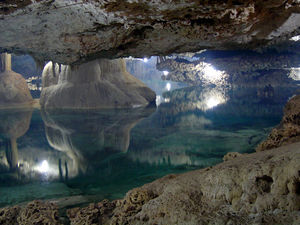Anchialine pools and cenotes
Introduction
Anchialine pools are brackish bodies of water that are land-locked. These pools experience tidal fluctuations and lack surface connections to the sea. They only occur in highly porous substrates like recent lavas or limestone that are near the ocean. There are many species that are endemic to anchialine pools including flora, fauna, and microbial communities. Anchialine pools are very common globally, located in the Red Sea on the Sinai Peninsula, islands in the Indian and Atlantic Oceans, and in the Pacific Ocean including the Hawaiian islands. They are also located on the Yucatan Peninsula, where they are known as cenotes. The majority of anchialine pools exist in the Hawaiian Islands, but these are being degraded by invasive species and anthropogenic distrurbances.
Cenotes are circular and cliffed sinkholes that contain watertable lakes. They formed by the dissolution of limestone by carbonic acid in karst areas and serve as the main sources of fresh water for humans and wildlife. They contain very clear water and large channels and characteristic heterogeneous vegetation, including tall evergreen trees like Ficus species, that surrounds the opening of the cenote. Cenotes are common on coastal karst plains with low topography. The most popular cenotes are located on the Yucatan Peninsula in Mexico and are the only known underground aquatic system located there. They are also located in the Florida peninsula, southeastern South Australia, South Africa, Turkey on the Anatolian Plateau, and the Bahamas Banks. In the Bahamas Banks, they occur onshore and offshore, where they occur as drowned cenotes called Blue Holes. Cenotes are threatened by nitrate contamination from untreated animal wastes, leaching of fertilizers, and vegetation removal. Since the water in these lakes is so clear, they are prime places for scuba diving and cave diving. Both of these activities also have the potential to harm the ecosystems that occur in cenotes.
The primary microbial communities that live in anchialine pools and cenotes include
Physical environment
Describe the physical and chemical characteristics of the environment, using as many sections/subsections as you require. If it is appropriate, you can divide the physical and chemical attributes of the environment into separate sections. Look at other topics available in MicrobeWiki. Which involve processes similar to yours? Create links where relevant.
Subsection 1
Subsection 1a
Subsection 1b
Subsection 2
Microbial communities
What kind of microbes do we typically find in this environment? Or associated with important processes in this environment? Describe key groups of microbes that we find in this environment, and any special adaptations they may have evolved to survive in this environment. List examples of specific microbes that represent key groups or are associated with important processes found in this environment. Link to other MicrobeWiki pages where possible.
Are there important biological interactions that are important in this environment? Do these interactions influence microbial populations and their activities? How do these interactions influence other organisms? Describe biological interactions that might take place in this environment, using as many sections/subsections as you require. Look at other topics available in MicrobeWiki. Create links where relevant.
Subsection 1
Subsection 1a
Subsection 1b
Subsection 2
Microbial processes
What microbial processes define this environment? Describe microbial processes that are important in this habitat, adding sections/subsections as needed. Look at other topics in MicrobeWiki. Are some of these processes already described? Create links where relevant.
Subsection 1
Subsection 1a
Subsection 1b
Subsection 2
Current Research
Enter summaries of recent research here--at least three required
References
Edited by Lauren Behnke, a student of Angela Kent at the University of Illinois at Urbana-Champaign.

